What We’re Reading: April 28
Correspondence: Discussion about the US National Academies GE crop report ($)
 A series of letters has been published in Nature Biotechnology on the topic of the US National Academies report Genetically Engineered Crops: Experiences and Prospects. From Dec 2016, US National Academies report misses the mark. In the April 2017 issue, authors of the report and others reply to the Dec letter: Elevating the conversation about GE crops and National Academies report has broad support. The authors of the original letter reply to both: Response to Gould et al. and Vincelli et al. This exchange should be interesting to anyone curious about policy, biotechnology, or GE crops, and can be used as learning opportunity for students. Nature Biotechnol. Tags: Applied Plant Biology, Education and Outreach, Policy
A series of letters has been published in Nature Biotechnology on the topic of the US National Academies report Genetically Engineered Crops: Experiences and Prospects. From Dec 2016, US National Academies report misses the mark. In the April 2017 issue, authors of the report and others reply to the Dec letter: Elevating the conversation about GE crops and National Academies report has broad support. The authors of the original letter reply to both: Response to Gould et al. and Vincelli et al. This exchange should be interesting to anyone curious about policy, biotechnology, or GE crops, and can be used as learning opportunity for students. Nature Biotechnol. Tags: Applied Plant Biology, Education and Outreach, Policy
Review: How multifaceted salicylic acid combats disease in plants and humans
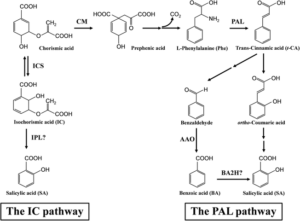 The journal BMC Biology publishes occasional Question and Answer articles, including a series on plant signals. In the latest installment of this series, Dempsey and Klessig write about the hormone salicylic acid (SA) and how it combats disease in plants and humans. The article focuses on SA in plants (synthesis, signalling, and function) but the inclusion of its use in medicine, first as a natural product and later as aspirin (acetylsalicylic acid), makes this fine review also useful for undergraduate education. BMC Biol. 10.1186/s12915-017-0364-8 Tags: Biotic Interactions, Education and Outreach, Signals and Responses
The journal BMC Biology publishes occasional Question and Answer articles, including a series on plant signals. In the latest installment of this series, Dempsey and Klessig write about the hormone salicylic acid (SA) and how it combats disease in plants and humans. The article focuses on SA in plants (synthesis, signalling, and function) but the inclusion of its use in medicine, first as a natural product and later as aspirin (acetylsalicylic acid), makes this fine review also useful for undergraduate education. BMC Biol. 10.1186/s12915-017-0364-8 Tags: Biotic Interactions, Education and Outreach, Signals and Responses
Review: Environmental regulation of intrinsic photosynthetic capacity: an integrated view ($)
 Photosynthetic capacity varies hugely within an individual over time, between individuals in different environments, and between species. Demming-Adams et al. review the processes that affect intrinsic photosynthetic capacity. Plants modulate their intrinsic photosynthetic capacity according to input (e.g., shade-grown plants generally have a lower capacity than plants growing in bright light), and demand (e.g., rate of export of photosynthetic products from the leaf and sink strength). Photosynthetic capacity can be governed by light harvesting capacity or CO2-fixing capacity and is affected by transport capacity, leaf thickness, developmental stage, temperature, stress and other factors. Understanding these factors can lead to increases in crop productivity. Curr. Opin. Plant Biol. 10.1016/j.pbi.2017.03.008 Tags: Bioenergetics, Ecophysiology, Physiology
Photosynthetic capacity varies hugely within an individual over time, between individuals in different environments, and between species. Demming-Adams et al. review the processes that affect intrinsic photosynthetic capacity. Plants modulate their intrinsic photosynthetic capacity according to input (e.g., shade-grown plants generally have a lower capacity than plants growing in bright light), and demand (e.g., rate of export of photosynthetic products from the leaf and sink strength). Photosynthetic capacity can be governed by light harvesting capacity or CO2-fixing capacity and is affected by transport capacity, leaf thickness, developmental stage, temperature, stress and other factors. Understanding these factors can lead to increases in crop productivity. Curr. Opin. Plant Biol. 10.1016/j.pbi.2017.03.008 Tags: Bioenergetics, Ecophysiology, Physiology
Review: Can modern agriculture be sustainable? Perennial polyculture holds promise
![]() Most of our major food crops are annuals, started from seed each year and fully harvested to collect the seeds at the end of their short growing season. By contrast, perennial crops are longer lived, and only partially harvested, so their biomass can increase from year to year. The larger root system of perennials can help with water and nutrient uptake, and help prevent soil erosion. Baker reviews efforts to develop and improve perennial crops, including domestication of wild perennial species and cross-breeding between annuals and perennials, as well as the use of genome mapping, and efforts understanding the interactions between perennials and the soil microbiome. Bioscience 10.1093/biosci/bix018 Tags: Applied Plant Biology, Biotic Interactions, Education and Outreach, Environmental Plant Biology, Genetics
Most of our major food crops are annuals, started from seed each year and fully harvested to collect the seeds at the end of their short growing season. By contrast, perennial crops are longer lived, and only partially harvested, so their biomass can increase from year to year. The larger root system of perennials can help with water and nutrient uptake, and help prevent soil erosion. Baker reviews efforts to develop and improve perennial crops, including domestication of wild perennial species and cross-breeding between annuals and perennials, as well as the use of genome mapping, and efforts understanding the interactions between perennials and the soil microbiome. Bioscience 10.1093/biosci/bix018 Tags: Applied Plant Biology, Biotic Interactions, Education and Outreach, Environmental Plant Biology, Genetics
Review: Novel consequences of bird pollination on plant mating
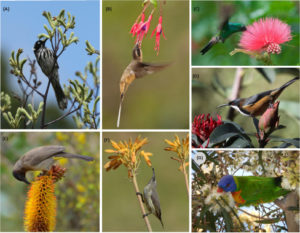 Pollination is an important evolutionary process as it allows gene flow. If pollen travels long distances, the likelihood of inbreeding is reduced and fitness may be increased. Pollen dispersal can be assisted by pollinators, and although most plants are pollinated by insects, birds are also important and contribute to pollination of around 500 vascular plant genera. In this review, Krauss et al. stress the importance of birds to pollen movement and how plant mating is affected by bird behavior. Bird pollination is a strong predictor of multiple paternity, which impacts genetic diversity and, in consequence, competition for maternal resources during seed maturation. Bird populations are also affected by climate change; a decline or range shift may also affect plant populations, especially in areas where plants rely on birds as pollinators, such as the tropics and the Southern Hemisphere. Keeping in mind the importance of birds for plant mating may help with restoration efforts under future climate change scenarios. (Summary by Gaby Auge) Trends Plant Sci. 10.1016/j.tplants.2017.03.005 Tags: Botany, Environmental Plant Biology
Pollination is an important evolutionary process as it allows gene flow. If pollen travels long distances, the likelihood of inbreeding is reduced and fitness may be increased. Pollen dispersal can be assisted by pollinators, and although most plants are pollinated by insects, birds are also important and contribute to pollination of around 500 vascular plant genera. In this review, Krauss et al. stress the importance of birds to pollen movement and how plant mating is affected by bird behavior. Bird pollination is a strong predictor of multiple paternity, which impacts genetic diversity and, in consequence, competition for maternal resources during seed maturation. Bird populations are also affected by climate change; a decline or range shift may also affect plant populations, especially in areas where plants rely on birds as pollinators, such as the tropics and the Southern Hemisphere. Keeping in mind the importance of birds for plant mating may help with restoration efforts under future climate change scenarios. (Summary by Gaby Auge) Trends Plant Sci. 10.1016/j.tplants.2017.03.005 Tags: Botany, Environmental Plant Biology
Opinion: Ménage-à-trois hypothesis of plastid endosymbiosis ($)
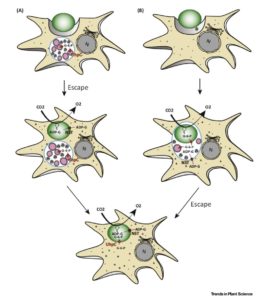 It is well established that plastids are derived from the primary endosymbiosis of an ancient cyanobacterium into a eukaryotic host cell, but this understanding does not explain all of the evidence, nor does it explain how the nascent endosymbiont evaded the host cell’s defense mechanisms. Recently, the ménage-à-trois hypothesis (MATH) was proposed. According to MATH, the eukaryotic host of the photosynthetic cyanobacterium also hosted an intracellular chlamydial pathogen (Chlamydiales are obligate intracellular bacterial pathogens and include the causal agent of a human sexually-transmitted disease). Cenci et al. review the evidence for MATH, which includes the presence of Chlamydiales genes in the eukaryotic host’s nucleus, and evidence of transporters and metabolic pathways of Chlymydiales origin. This hypothesis suggests that the success of the primary endosymbiosis was due in part to a pre-adaptation of the host that facilitated its success. Trends Plant Sci. 10.1016/j.tplants.2016.12.007 Tags: Bioenergetics, Botany, Evolution
It is well established that plastids are derived from the primary endosymbiosis of an ancient cyanobacterium into a eukaryotic host cell, but this understanding does not explain all of the evidence, nor does it explain how the nascent endosymbiont evaded the host cell’s defense mechanisms. Recently, the ménage-à-trois hypothesis (MATH) was proposed. According to MATH, the eukaryotic host of the photosynthetic cyanobacterium also hosted an intracellular chlamydial pathogen (Chlamydiales are obligate intracellular bacterial pathogens and include the causal agent of a human sexually-transmitted disease). Cenci et al. review the evidence for MATH, which includes the presence of Chlamydiales genes in the eukaryotic host’s nucleus, and evidence of transporters and metabolic pathways of Chlymydiales origin. This hypothesis suggests that the success of the primary endosymbiosis was due in part to a pre-adaptation of the host that facilitated its success. Trends Plant Sci. 10.1016/j.tplants.2016.12.007 Tags: Bioenergetics, Botany, Evolution
H2A monoubiquitination in Arabidopsis is generally independent of LHP1 and PRC2 activity
 Gene silencing by chromatin marks occurs in plants and animals, but there are often some differences in the details. Polycomb repressive complex 1 (PRC1) and PRC2 were first characterized in animals and shown to repress gene expression in part through histone modification; PRC1 has histone H2A E3 ubiquitin ligase activity, and PRC2 has histone H3 lysine 27 (H3K27) tri-methyltransferase activity. In animals, the classic hierarchical model for Polycomb group (PcG) complex recruitment proposes that the H3K27me3 produced by PRC2 recruits PRC1, leading to H2A ubiquitination. Zhou and Romero-Campero et al. investigated histone modifications genome-wide in wild-type and mutant plants to determine whether this activity sequence holds true in plants, and found that it does not; PRC2 activity is dispensable to establish H2AK121ub marks at most genes. Genome Biol. 10.1186/s13059-017-1197-z Tags: Gene Regulation, Genomics
Gene silencing by chromatin marks occurs in plants and animals, but there are often some differences in the details. Polycomb repressive complex 1 (PRC1) and PRC2 were first characterized in animals and shown to repress gene expression in part through histone modification; PRC1 has histone H2A E3 ubiquitin ligase activity, and PRC2 has histone H3 lysine 27 (H3K27) tri-methyltransferase activity. In animals, the classic hierarchical model for Polycomb group (PcG) complex recruitment proposes that the H3K27me3 produced by PRC2 recruits PRC1, leading to H2A ubiquitination. Zhou and Romero-Campero et al. investigated histone modifications genome-wide in wild-type and mutant plants to determine whether this activity sequence holds true in plants, and found that it does not; PRC2 activity is dispensable to establish H2AK121ub marks at most genes. Genome Biol. 10.1186/s13059-017-1197-z Tags: Gene Regulation, Genomics
The emergence, evolution, and diversification of the miR390-TAS3-ARF pathway in land plants ($)
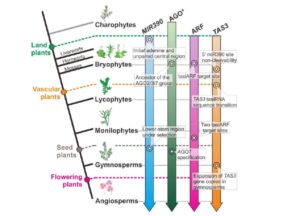 Trans-acting small interfering RNAs (tasiRNAs) are unique to plants. They are the products of TAS genes, but they function to regulate other genes (thus the name “trans-acting”). The production of tasiRNAs requires miRNAs, which bind to and ultimately lead to cleavage of the primary TAS transcript. TAS3 is the best studied TAS gene. Its production depends on miR390, and its tasiRNA products target AUXIN RESPONSIVE FACTOR (ARF) genes. Xia et al. characterized genes corresponding to the miR390-TAS3-ARF pathway in thousands of plant species to uncover their evolutionary trajectories. Their data “illuminate the evolutionary path of the miR390-TAS3-ARF pathway in land plants, and demonstrate the significant variation that occurs in this functionally important and archetypal regulatory circuit.” Plant Cell 10.1105/tpc.17.00185 Tags: Evolution, Gene Regulation, Molecular Biology
Trans-acting small interfering RNAs (tasiRNAs) are unique to plants. They are the products of TAS genes, but they function to regulate other genes (thus the name “trans-acting”). The production of tasiRNAs requires miRNAs, which bind to and ultimately lead to cleavage of the primary TAS transcript. TAS3 is the best studied TAS gene. Its production depends on miR390, and its tasiRNA products target AUXIN RESPONSIVE FACTOR (ARF) genes. Xia et al. characterized genes corresponding to the miR390-TAS3-ARF pathway in thousands of plant species to uncover their evolutionary trajectories. Their data “illuminate the evolutionary path of the miR390-TAS3-ARF pathway in land plants, and demonstrate the significant variation that occurs in this functionally important and archetypal regulatory circuit.” Plant Cell 10.1105/tpc.17.00185 Tags: Evolution, Gene Regulation, Molecular Biology
Suppression of plant hypoxia responses by cysteine oxidases and arginyl transferases that initiate transcription factor turnover by N-end rule pathway

Flooding “drowns” plants by depriving them of oxygen, leading to hypoxia and ultimately death. Ethylene-responsive transcription factors (ERFs) have been identified that induce expression of genes to support anaerobic metabolism and are critical for hypoxia survival. ERFs are selectively destabilized in normal oxygen environment (normoxia), through a turnover response known as the N-end rule pathway, in which their N-terminal methionine is removed to expose a cysteine that is susceptible to oxidation, triggering a proteolytic turnover process. White et al. show the first direct biochemical evidence for the formation of Cys-sulfinic acid (CysO2) by PLANT CYSTEINE OXIDASEs (PCOs) and that this reaction involves the incorporation of molecular oxygen (O2). Furthermore, the authors show that CysO2 is a direct substrate for arginylation by ARGINYLTRANSFERASE 1 (ATE1) which is the entry point to proteolytic degradation in vivo. These findings may lead to the development of plants with improved flooding tolerance. Nature Comms. 10.1038/ncomms14690 Tags: Abiotic Interactions, Biochemistry, Gene Regulation
PIF4-controlled auxin pathway contributes to hybrid vigor in Arabidopsis thaliana
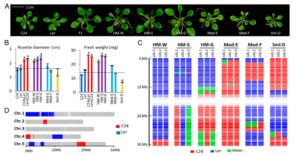 Hybrid vigor is a well-known but still poorly understood phenomenon in which the F1 hybrid progeny of a cross often show enhanced growth as compared to either parent. True-breeding lines that retain this enhanced growth, known as hybrid mimics, have been developed and are important tools for understanding hybrid vigor. Wang et al. characterized several hybrid mimic lines as well as true-breeding lines with a medium (parental-like) or small phenotype. They identified several chromosomal regions and differentially-expressed genes associated with the large or small phenotype. One of the differentially expressed genes associated with larger size, PIF4, encodes a transcription factor that contributes to auxin synthesis, which may contribute directly to the larger size of the hybrid mimics. Proc. Natl. Acad. Sci. USA 10.1073/pnas.1703179114 Tags: Genetics, Genomics, Growth Regulation, Signals and Responses
Hybrid vigor is a well-known but still poorly understood phenomenon in which the F1 hybrid progeny of a cross often show enhanced growth as compared to either parent. True-breeding lines that retain this enhanced growth, known as hybrid mimics, have been developed and are important tools for understanding hybrid vigor. Wang et al. characterized several hybrid mimic lines as well as true-breeding lines with a medium (parental-like) or small phenotype. They identified several chromosomal regions and differentially-expressed genes associated with the large or small phenotype. One of the differentially expressed genes associated with larger size, PIF4, encodes a transcription factor that contributes to auxin synthesis, which may contribute directly to the larger size of the hybrid mimics. Proc. Natl. Acad. Sci. USA 10.1073/pnas.1703179114 Tags: Genetics, Genomics, Growth Regulation, Signals and Responses
LIL3, a light-harvesting complex protein, links terpenoid and tetrapyrrole biosynthesis
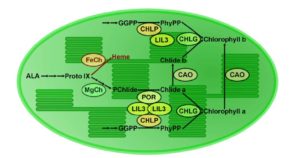 The final step in the synthesis of chlorophyll is the joining of chlorophyllide, (a tetrapyrrole with planar structure similar to heme) to a linear lipid (a product of the terpenoid pathway) that provides an attachment point for the resulting chlorophyll to pigment-binding proteins of the light-harvesting complexes. LIL3 (Light-harvesting-Like) is a membrane-spanning protein that was previously shown to interact with geranylgeranylreductase (CHLP), an enzyme involved in terpene biosynthesis. Hey et al. show that LIL3 also interacts with protochlorophyllide oxidoreductase (POR), the enzyme that catalyzes chlorophyllide production, as well as its substrate, protochlorophyllide. The authors suggest that through these interactions, LIL3 may serve to coordinate the production of the two intermediates required for chlorophyll production. Plant Physiol. 10.1104/pp.17.00505 Tags: Biochemistry, Bioenergetics
The final step in the synthesis of chlorophyll is the joining of chlorophyllide, (a tetrapyrrole with planar structure similar to heme) to a linear lipid (a product of the terpenoid pathway) that provides an attachment point for the resulting chlorophyll to pigment-binding proteins of the light-harvesting complexes. LIL3 (Light-harvesting-Like) is a membrane-spanning protein that was previously shown to interact with geranylgeranylreductase (CHLP), an enzyme involved in terpene biosynthesis. Hey et al. show that LIL3 also interacts with protochlorophyllide oxidoreductase (POR), the enzyme that catalyzes chlorophyllide production, as well as its substrate, protochlorophyllide. The authors suggest that through these interactions, LIL3 may serve to coordinate the production of the two intermediates required for chlorophyll production. Plant Physiol. 10.1104/pp.17.00505 Tags: Biochemistry, Bioenergetics
Zeaxanthin-dependent nonphotochemical quenching does not occur in photosystem I in Arabidopsis thaliana
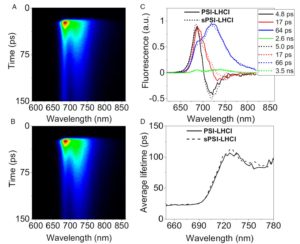 Photosynthesis in plants involves two photosystems acting in series, Photosystem I (PSI) and PSII. Each photosystem is a massive complex consisting of numerous proteins and pigments. The photosystems are efficient at light harvesting but also sensitive to high-light induced photooxidative damage. Photosynthetic organisms have several ways to protect against high-light damage, one of which is a form of non-photochemical quenching (NPQ) that occurs when zeaxanthin is produced from violaxanthin. Zeaxanthin-dependent NPQ was associated solely with PSII, until a recent study of a zeaxanthin over-expressing mutant indicated that it also contributes quenching to PSI. However, here Tian et al. show that in biologically relevant conditions zeaxanthin does not lead to PSI quenching. Proc. Natl. Acad. Sci. USA 10.1073/pnas.1621051114 Tags: Biochemistry, Bioenergetics
Photosynthesis in plants involves two photosystems acting in series, Photosystem I (PSI) and PSII. Each photosystem is a massive complex consisting of numerous proteins and pigments. The photosystems are efficient at light harvesting but also sensitive to high-light induced photooxidative damage. Photosynthetic organisms have several ways to protect against high-light damage, one of which is a form of non-photochemical quenching (NPQ) that occurs when zeaxanthin is produced from violaxanthin. Zeaxanthin-dependent NPQ was associated solely with PSII, until a recent study of a zeaxanthin over-expressing mutant indicated that it also contributes quenching to PSI. However, here Tian et al. show that in biologically relevant conditions zeaxanthin does not lead to PSI quenching. Proc. Natl. Acad. Sci. USA 10.1073/pnas.1621051114 Tags: Biochemistry, Bioenergetics
Tissue-specific transcriptomics shows the unfolded protein response’s role in maintaining fertility upon heat stress ($)
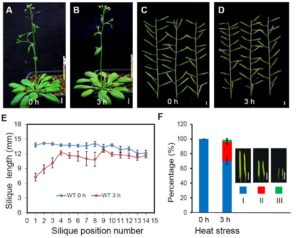 Plant reproduction is particularly sensitive to heat stress, so rising temperature is a major threat to food security. Zhang et al. surveyed the transcriptional responses to heat stress (3 h at 37º) in Arabidopsis and identified large differences between vegetative and reproductive tissue responses to heat. In reproductive tissue, heat-responsive genes include those participating in the unfolded protein response (UPR), a eukaryote-wide signalling pathway in which unfolded proteins in the ER initiate signals that are transduced to the nucleus and lead to the expression of stress-response genes. bZIP28 and bZIP60 are two key transcription factors involved in the UPR, and bZIP28 / bZIP60 double mutants are particularly vulnerable to heat stress, demonstrating that the UPR protects reproductive development during heat stress. Plant Cell 10.1105/tpc.16.00916 Tags: Abiotic Interactions, Genomics
Plant reproduction is particularly sensitive to heat stress, so rising temperature is a major threat to food security. Zhang et al. surveyed the transcriptional responses to heat stress (3 h at 37º) in Arabidopsis and identified large differences between vegetative and reproductive tissue responses to heat. In reproductive tissue, heat-responsive genes include those participating in the unfolded protein response (UPR), a eukaryote-wide signalling pathway in which unfolded proteins in the ER initiate signals that are transduced to the nucleus and lead to the expression of stress-response genes. bZIP28 and bZIP60 are two key transcription factors involved in the UPR, and bZIP28 / bZIP60 double mutants are particularly vulnerable to heat stress, demonstrating that the UPR protects reproductive development during heat stress. Plant Cell 10.1105/tpc.16.00916 Tags: Abiotic Interactions, Genomics
Brassica oilseeds transporter gene mutations decrease antinutritional glucosinolates
 Glucosinolates are sulfur-containing defense compounds produced by brassica plants. Brassica napus (canola) is an important oilseed crop because a low-glucosinolate variety has been developed. Brassica juncea is more stress tolerant, but has not been developed as a crop due to its high levels of glucosinolates. In a “transport engineering” approach, Nour-Eldin et al. identified glucosinolate transport proteins highly expressed in seeds, and then found loss-of-function mutants in these genes. Production of double, triple and quadruple mutants led to a significant reduction of seed glucosinolate production, although not yet to the point needed for commercial use. Nature Biotech. 10.1038/nbt.3823 Tags: Applied Plant Biology, Genetics, Transporters
Glucosinolates are sulfur-containing defense compounds produced by brassica plants. Brassica napus (canola) is an important oilseed crop because a low-glucosinolate variety has been developed. Brassica juncea is more stress tolerant, but has not been developed as a crop due to its high levels of glucosinolates. In a “transport engineering” approach, Nour-Eldin et al. identified glucosinolate transport proteins highly expressed in seeds, and then found loss-of-function mutants in these genes. Production of double, triple and quadruple mutants led to a significant reduction of seed glucosinolate production, although not yet to the point needed for commercial use. Nature Biotech. 10.1038/nbt.3823 Tags: Applied Plant Biology, Genetics, Transporters




Leave a Reply
Want to join the discussion?Feel free to contribute!